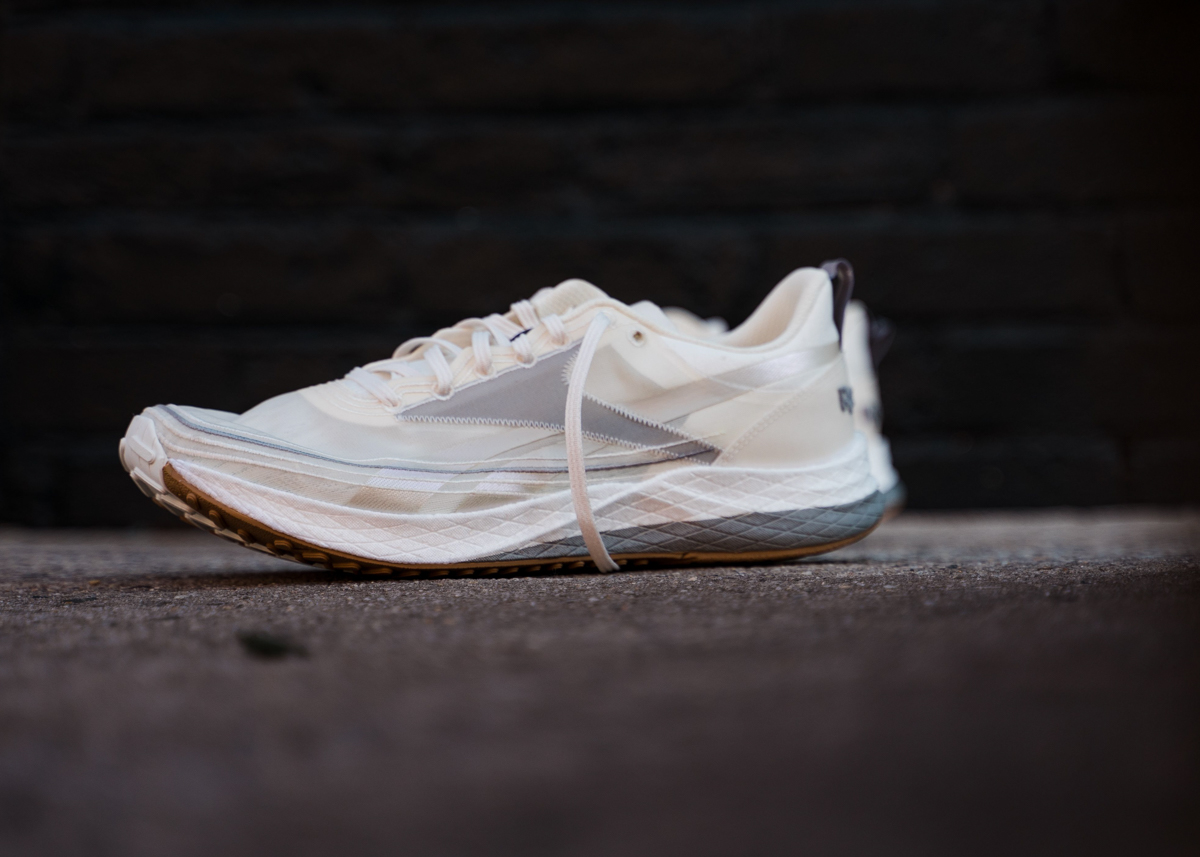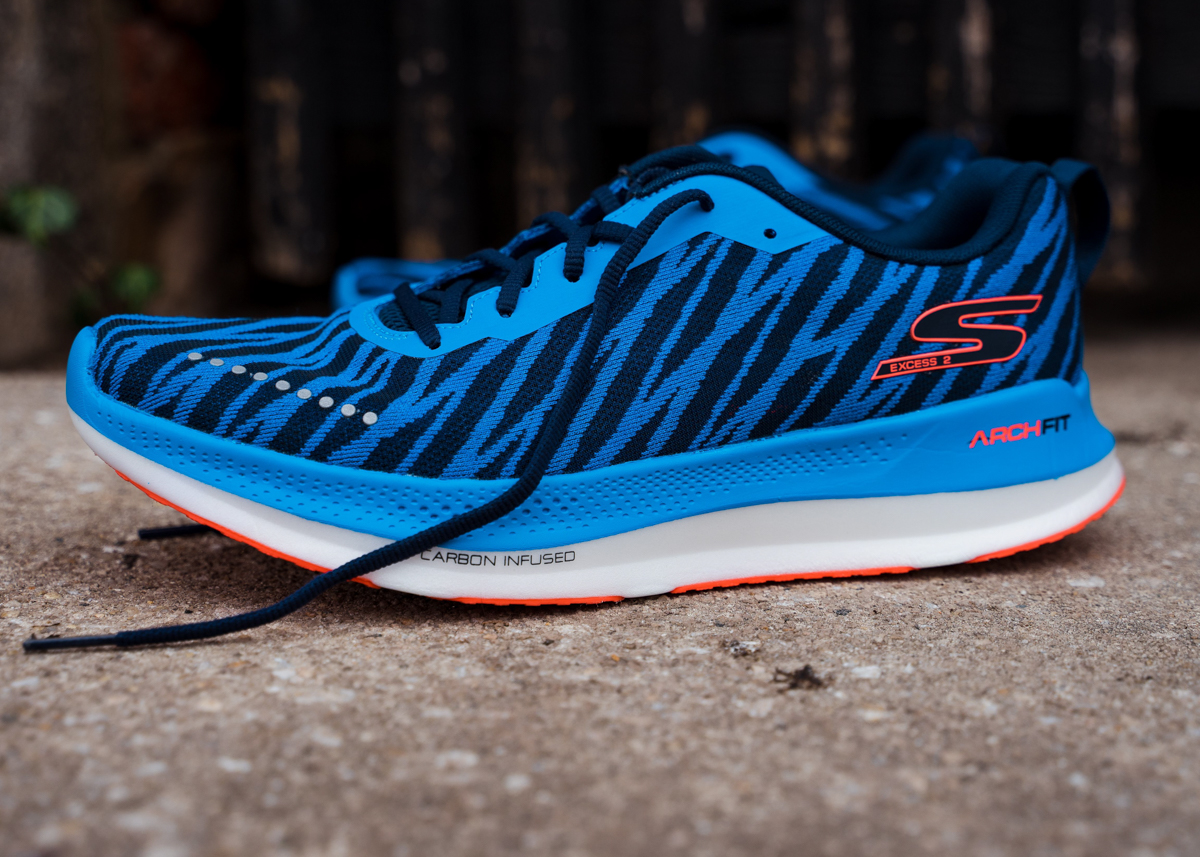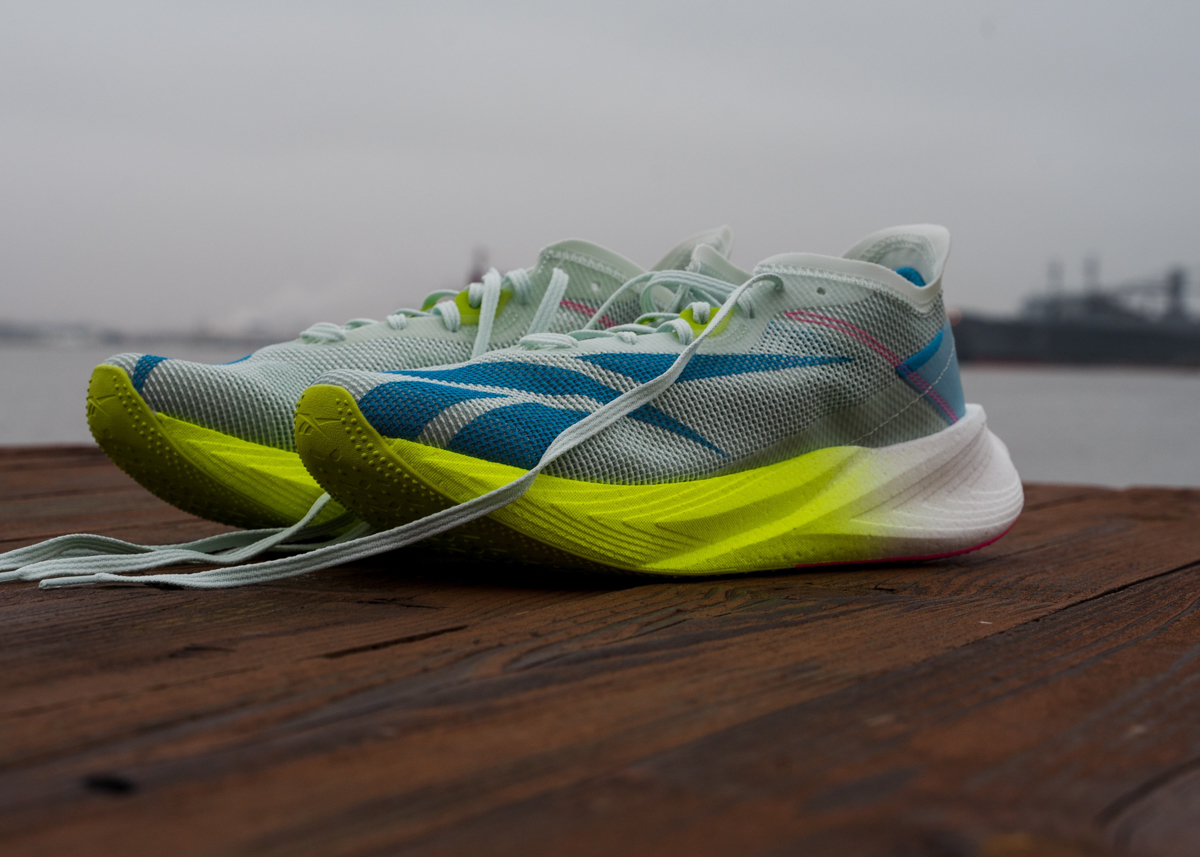
MEAGHAN: A carbon-plated race shoe for under $200? Yep, Reebok just launched the Floatride Energy X for a mere $170. The brand’s latest addition to the Floatride line is here to make race day shoes more accessible to everyone.
BRANDON: Reebok’s been coming out with some pretty impressive tech lately. The Floatride Energy X is another one that surprised me — in a good way. This is Reebok’s premier race day super shoe. I have to be very clear and honest with y’all: It doesn’t live up to the hype of some of the other traditional super shoes out on the market. However, that doesn’t mean it’s a bad shoe or doesn’t have a purpose. The Floatride Energy X is a great shoe, especially for $170. Most super shoes and race day shoes are far north of $200, so it’s nice to see that Reebok is pricing its shoes at a more affordable point.
Maybe it’s not the best race day shoe on the market, but I’ve found that the shoe can be useful for workout and tempo days. It’s great for when you still want to pick up the pace and not use up all of your miles in your precious Alphafly or Vaporfly.
BEN: Reebok has stayed out of the hype running shoe spotlight over the last few years, but it’s released some solid offerings with confusing names. Here’s a quick rundown on their two main product lines: First is the Floatride Run lineup, with shoes like the Run, Run Fast, and Run Fast Pro. These options used the Floatride foam that was PEBA-based (back before everyone clamored to make super foam shoes). Reebok also has its Floatride Energy shoes, like the Forever Floatride Energy and the Floatride Energy. If you’ve followed along with the naming scheme, hopefully you’ve picked up that the Reebok Floatride Energy X is a new member in the latter lineup (for simplicity’s sake, I’m calling it the Energy X from now on).
The Floatride Run (PEBA foam) shoes were more race-focused, lightweight, and expensive. The Floatride Energy foam (as found on the Energy X) has shown itself to be a very solid option, and it’s allowed these shoes to come in at a more reasonable price point. Regardless of the foam choice, the common theme with almost all the prior Reebok offerings is that they’ve been lower stack heights and generally offered more flexible midsoles. The Energy X changes that with a full bed of Floatride Energy midsole foam and a forefoot carbon plate. Underneath is a rubber outsole with the midfoot exposed and a large cavity for weight savings.
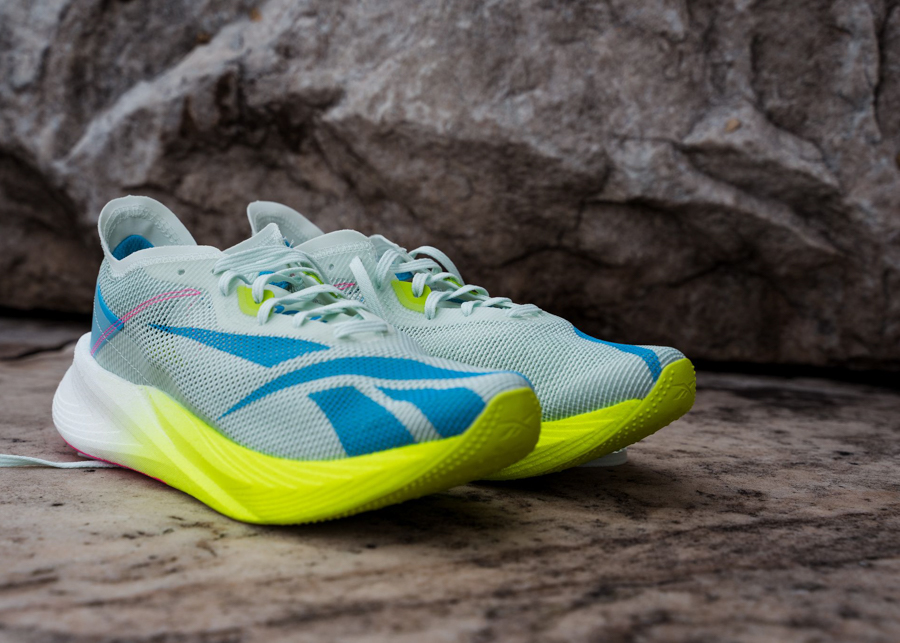
MEAGHAN: The Floatride Energy X is designed for race day and long-distance training. I haven’t taken this shoe out for anything longer than a 10-mile run, but I wouldn’t hesitate to use it for those long marathon training days.
The upper is recycled plastic Flexweave that’s not super stretchy but very breathable and surprisingly comfortable. The gusseted tongue and flat, asymmetrical laces do a good job of locking the foot down, and there’s some internal padding around the collar and heel for added comfort and a secure fit. Reebok only offers the Floatride Energy X in full sizes, so I opted for a US W8 (instead of my typical 7.5), and while it was a touch long, the slightly larger build didn’t bother me much at all.
Beneath the foot is a pretty decent slab of Floatride Energy foam. In fact, it’s the most Floatride Energy cushioning Reebok has ever put in a shoe (30mm in the heel and 24mm in the forefoot, for a 6mm drop). I enjoyed the ride. It’s soft yet bouncy, and the rocker geometry provides a nice, smooth transition. The forefoot carbon plate adds some rigidity and stability, and the rubber lugs on the outsole add traction and durability. Overall, it’s definitely one of the more stable super shoes.
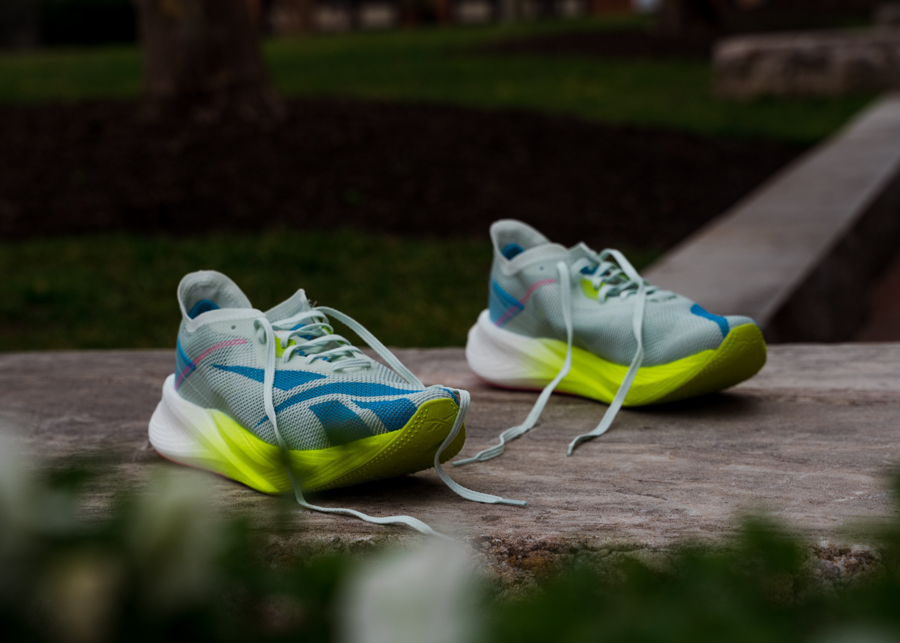
BRANDON: The winner here is Reebok’s Floatride Energy foam like Meg said. I wished for more of it underfoot in the Floatride Energy 4, and now I have it. Solving that problem alone allows for a more suitable and comfortable ride underfoot for me.
Like I mentioned earlier, it’s a (relatively) cheap shoe, only coming in around $170. Whether you use it for daily training, workouts, or race day, the price justifies it sitting in almost every category. The outsole rubber is strong and durable. Sure, there may not be too much of it, but the targeted rubber lugs offer ample grip underfoot. I’ve used this shoe for workouts, long runs, and tempos, and you’ll be well-off if you do the same.
BEN: The Energy X is poised as an affordable carbon plated marathon racing option, and I think it fits this description well. It retails for $170, putting it at a price tier below the rest of the carbon-plated racer competition. The shoe fits me well, and the gusseted tongue makes slipping it on and getting laced up a breeze. The heel has a moderate amount of structure and a semi-circle of padding to help cradle the back of the foot. I found the shoe comfortable on step-in and had the same impression on the run. I was able to use this shoe at a variety of paces.
The midsole has a wide platform, both in the forefoot and the heel. This allows it to be relatively stable, despite the higher stack height. I think this could be a shoe to consider for those looking to get into a carbon-plated racer if other options have been too unstable. For me, the traction was good, and the rocker helps when you want to hit harder efforts. The midsole foam offers plenty of cushion for any distance, and the forefoot plate is accommodating enough to handle more moderate paces but comes to life at faster speeds.
Shop Reebok Floatride Energy X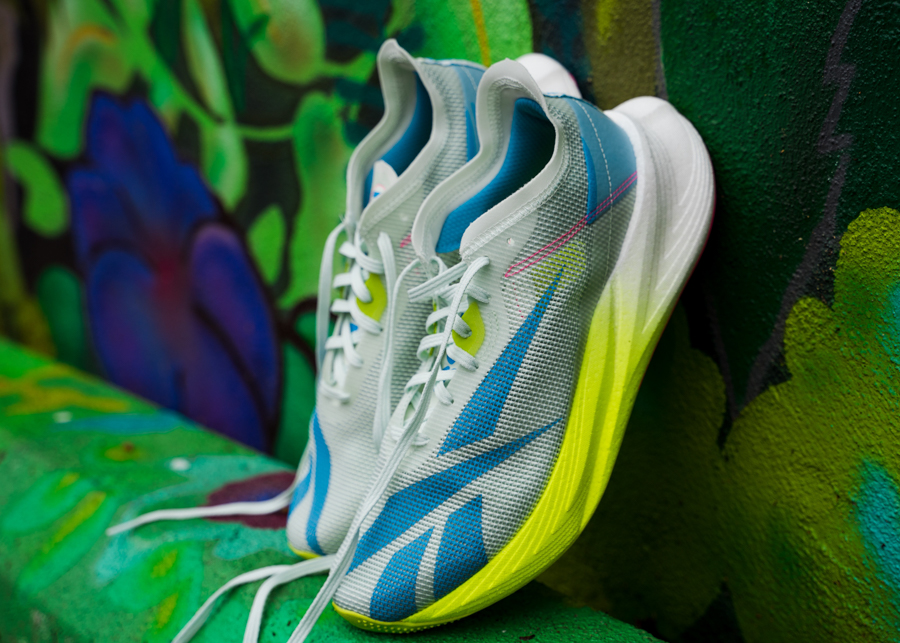
MEAGHAN: This shoe isn’t super light, especially if we’re talking race day. My US W8 came in right around 8 oz. (225 g.), nearly 2 oz. heavier than most super shoes.
I also had to stop several times to retie my laces, which would be particularly annoying if you’re in the middle of a workout, or race, for that matter. The Floatride Energy X could also benefit from a pull tab, as it’s not the easiest shoe to get on.
BRANDON: Carbon plates seem to be where it’s at these days. With shoes leaning towards higher stacks, companies are looking for ways to stabilize that foam with a plate. The Floatride X has a carbon plate in the forefoot for added stability and rigidity when toeing off into the next stride. It’s nice to know it’s there, but I’m not sure I felt that pop the way I wanted to. The shoe doesn’t exactly scream race day.
The foam is solid but way too blocky and not very flexible underfoot. Couple that with some fit issues in the upper, and it can make for a pretty wonky ride at times. I’ve saved talking about the upper for now because I have some beef. I run in a US M8.5, but Reebok is only making the shoe in full sizes. I went up to a US M9 and found the shoe way too big and wide. Everyone wants wider and wider shoes, and it’s taking away from that nimble and tight fit I love on race day. The heel collar leaves more to desire and does a poor job locking down the foot. I found myself slipping out of the shoe due to how wide the construction of it is.
BEN: This shoe is available in unisex sizing with whole sizes only (Men’s 6 to 12, which translates to Women’s 7.5 to 13.5). I usually wear a US M9.5 so this put me in no man’s land. I initially got a US M10 and found it fit OK, but a bit long and sloppy at faster speeds. I was able to swap for a US M9, and the fit worked much better for me. My recommendation would be to size down a half size if you’re between, but I’d consider the lack of half sizes disappointing.
Despite a lot of good things going for this shoe, I’d still consider the overall performance a step down from the top-tier race shoes. One aspect of this is the weight. My US M9 weighs 260g (9.2oz) — much heavier than some of the other race day options. The Floatride Energy foam is also a step down from the top offerings. It provides good cushion and decent rebound, but lacks some of that race day pop.
Shop Reebok Floatride Energy X
MEAGHAN: The Reebok Floatride Energy X falls into a very similar category as the Altra Vanish Carbon for me. I enjoyed the fit and ride. It’s great for long runs and uptempo days, but it lacks the pop and light build of a true race day super shoe. I’ll keep the Floatride Energy X in my rotation, but I won’t be lacing it up for race day.
BRANDON: The Reebok Floatride Energy X is a good shoe, but not for racing. I’d recommend this shoe to anyone looking for a responsive and cushioned trainer for workout and tempo days. It’s not really for me, but I can see how this one would work for someone else. At $170, it might just be worth the gamble.
BEN: Reebok promised a reasonably priced marathon racer and trainer, and this shoe hits the mark. It’s a comfortable fit and ride, with plenty of cushion and extra pep from a forefoot carbon plate. It’s a step back from some other race options due to weight and midsole foam, but it compares well against shoes like the Nike Zoom Fly 4 and New Balance FuelCell TC (RIP). Both are similar in weight and come with midsole foams that are a step down from their respective brands’ super foams. I wouldn’t consider the Reebok Floatride Energy X my race day pick, but if you’re looking to keep the price down or simply want a versatile trainer/racer, this is a shoe to look at.
You can pick up the Reebok Floatride Energy X for $170 by using the shop link below.
Shop Reebok Floatride Energy X
Want to learn more about how our review process works? Check out this guide.
Have something to say? Leave a Comment
